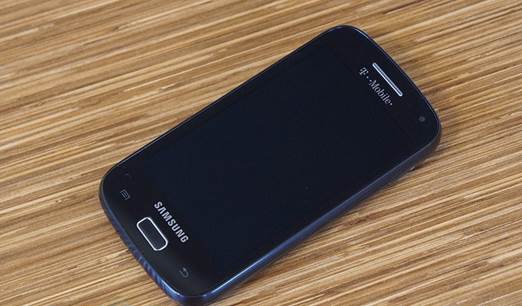Complaints about the Samsung Galaxy S Blaze
Q slider had been voiced out back in August 2012, and the only outstanding
point - except for the Qualcomm Snapdragon S4 processor and HSPA+42 connectivity
was that lengthy name. Afterward, it is fascinating that Sammy should call the
T-Mobile device with a name that does not justify its identity: the Galaxy S
Relay 4G. Left alone the confusion regarding the name, the handset offers a
five-row QWERTY layout, a dual-core S4 chip and a 5-megapixel camera with LED
flash, all for the reasonable price of $150 (with a $50 mail-in rebate). Is
this slider the best T-Mobile has for the market? Let’s try to take a closer
look at it.

Samsung
Galaxy S Relay 4G
Hardware
The Relay 4G won't go far from any
conception of a slider: at 4.9 x 2.5 inches (125.9 x 64.9mm) and 0.5 inches
(13.4mm) thick, at least it has more or less the same brick shape of other
handsets with QWERTY keyboards. At 5.3 ounces (150 grams), this phone is not
heavier than its competitors (the Motorola Droid 4 weighs 6.3 ounces, and the
T-Mobile my Touch Q is a hefty 6.5). However, the extra girth that comes with a
slide-out keyboard could assure that user would never mistake the Relay with
other fragile, touchscreen-only Android phones.

The
Relay 4G won't go far from any conception of a slider: at 4.9 x 2.5 inches
(125.9 x 64.9mm) and 0.5 inches (13.4mm) thick
Same as the Samsung Captivate Glide from
late 2011, the Relay is quite a shaggy-version of a QWERTY slider. Competing
handsets like Motorola's Photon Q 4G LTE and Droid 4 sport sharp, diagonally
cut corners, such design may take away from the otherwise boxy dimensions.
Meanwhile, we are in love with the smoothly rounded edges of the Relay 4G, which
fit the palm perfectly. A soft, slightly convex back is also tailor-model for a
solid grip, and truly the Relay creates such a good feeling in hand. The 4-inch
screen allows you to experience a nice display, but it doesn't push the reach
of smaller hands to the limit.
Many of the phone's backing sport the soft
surface, which is relatively similar to that of the Samsung Galaxy S Blaze 4G,
but the bottommost part is made of plastic and leaves some space for two mini
speaker grilles. The 5-megapixel camera and LED flash are located at the
device's rear side, underneath is the Galaxy S logo carved directly to the
phone. There are also additional labels occupying the front side of the device:
Samsung's moniker stays right below the screen, and T-Mobile sticks its name
over the top of the handset. It is so shameful for such a charmingly minimalist
design to be cheapened by all that branding; if only the carrier and producer
had known to constraint and omitted its logo.
A big home button, along with smaller ones
indicating Settings and Back, located at the bottom front of the Relay. The
upper part of the front face is lined with the LED notification light, earpiece
and 1.3-MP front-facing shooter. The power button stays on the right edge,
while the 3.5mm headphone jack is on the top. The volume rocker could be found
on the left edge, and the micro-USB port lines the bottom side. There is also
microSD card slot for expanding the humble 8GB internal memory of the phone up
to an extra 32GB, still you would have to remove the backing to get to it.
Having a deeper look inside, we have 1.5GHz
dual-core Snapdragon S4 CPU, 1GB of RAM and an internal storage of 8GB. However
in reality, users can only have access to about 5GB of on-board one. The phone
supports quad-band DC-HSPA+ / UMTS (850/AWS/1,900/2,100MHz) in addition to GSM
(850/900/1,800/1,900MHz) for roaming the globe. (We will talk about network
performance later.)
The 4-inch screen of the Relay 4G sports a
WVGA (480x800) resolution and is made of Gorilla Glass 2, a material which has
proven to be scratch-free. We are satisfied with this additional protection
layer. Nevertheless, this Super AMOLED PenTile panel alone is enough to send
shudders down the most hardcore screen savvy. Indeed, it is such a huge
disappointment that Sammy's still glued to Super AMOLED mode: we've been seeing
basically this same panel since the original Galaxy S debuted in 2010. The
technology might have been remarkable then, but the bar has continuously since
been raised, and this display on a $150 device is absolutely underwhelming.

The
4-inch screen of the Relay 4G sports a WVGA (480x800) resolution and is made of
Gorilla Glass 2, a material which has proven to be scratch-free.
It is the fact that this screen isn't
superior - pictures and text show some small but apparent blurriness. By that
saying, the display is not hideous either. Viewing angles are wide and colors
are bright and accurate, if not notably vibrant. On the other hand, try to use
the phone under the sun and you'll be lucky to make out anything on the panel:
it's definitely acceptable for email checking and internet surfing, but you'll
want to turn elsewhere to get you outdoor reading fix, not to mention your
1080p trailer.